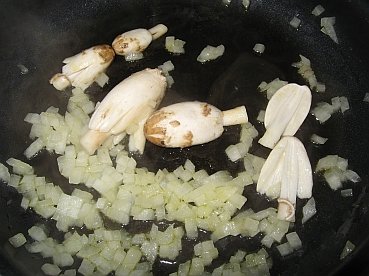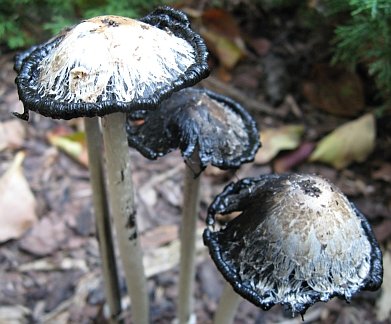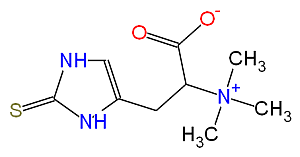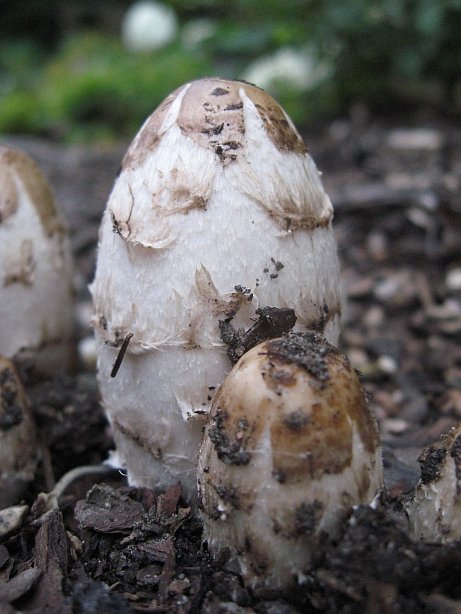The shaggy mane, Coprinus comatus growing in wood chips.
Classification
Kingdom Fungi
Phylum Basidiomycota
Class Basidiomycetes
Order Agaricales
Family Agaricaceae
Genus Coprinus
Common names
Shaggy mane
Shaggy ink cap
Lawyer’s wig
Shaggy parasol
Spargelschopf [Asparagus Top] (German)
What is Shaggy Mane Mushroom?
Identification
Cap: 2.5-5 cm wide; oval to cylindrical, aging to convex or bell-shaped; dry; with shallow grooves near the edge; white, with reddish brown scales. Flesh soft, white.
Gills: free of the stalk, very crowded together, white when very young, becoming gray, then black, and dissolving (deliquescing) with age.
Stalk: 5-20 cm long, 1-2.5 cm thick, becoming enlarged at the base; white, with a hollow interior; with a white, ring-like zone of fibers near the base.
Spore print: black.
Habitat: solitary, scattered, or clustered on lawns, in pastures, or along roadsides; spring, fall, and early winter.
The shaggy mane is a favorite amongst mushroom hunters as it is easily recognized, with no dangerous look-alikes. Furthermore, it is a delicious edible.

However, be sure to cook your specimens shortly after picking; this species will auto-digest (deliquesce) and will probably not last in your refrigerator overnight.

Bioactive compounds
Carbohydrates
Using the Limulus Factor G test, the amount of (1→3)-β–glucan has been quantified in C. comatus (in addition to various other fungi). The Limulus Factor G test is normally used to measure the (1→3)-β–glucan content in human serum resulting from infection by disease-causing fungi like Candida or Aspergillus, to help clinicians in early diagnosis of infection. However, it is also suitable for detecting (1→3)-β-glucan content in crude mushroom polysaccharide extracts. C. comatus was identified as having ‘superior’ (1→3)-β–glucan content, compared to 18 other medicinal or edible species (Yang et al., 2003).
The chemical structure of a water-soluble fucogalactan obtained from the crude intracellular polysaccharide of Coprinus comatus mycelium was characterized by sugar and methylation analysis along with 1H and 13C NMR spectroscopy. The polysaccharide is composed of a pentasaccharide repeating unit (Fan et al., 2006).

My name is Austin Collins.
I've dedicated my life to Mushrooms.
I believe Mushrooms are the best kept secret when it comes to health and well being.
For that reason, I would like to share a company with you that in my opinion makes the best mushroom products on the market.
The company is called Noomadic Herbals, my favorite supplement they make is called "Mushroom Total".
I take their products every day and they have helped me think better and have more energy. Give them a try.
-Austin
Shaggy Mane Benefits & Medicinal Properties
Anti-tumor activity
The water extract of Coprinus comatus was recently identified as containing potent antitumor compounds for breast cancer. Because breast cancer is the most commonly diagnosed cancer among women worldwide, and because there is no effective therapy for estrogen-independent (ER-) breast cancer, these findings are highly significant. The antitumor potential of the water extract was shown to manifest itself in three ways:
1) it inhibited the growth of both ER+ and ER- breast cancer cells
2) it induced both ER+ and ER- cells to die (apoptosis)
3) it inhibited tumor colony formation in vitro
(Gu and Leonard, 2006)
An alkaline protein named y3, purified from fruiting bodies of C. comatus, was shown to inhibit a gastric cancer cell line with an IC50 of 12 µg/mL (Wu et al., 2003).
Serum lysozyme activity is used as a general indicator of immune system fitness. In addition to breaking down polysaccharides found in bacterial cell walls, lysozyme can also bind to the surface of some invading bacteria and make it easier for white blood cells to engulf them. Chinese research has shown that polysaccharide solutions extracted from C. comatus and given to mice had the ability to increase serum lysozyme activity (Li et al., 2001).
Hypoglycemic effects
A number of studies have demonstrated that consumption of C. comatus can help regulate blood glucose concentrations. Feeding mice a diet containing powdered dried fruit bodies of C. comatus (one-third of their food intake, by weight) reduced their plasma glucose concentrations and improved intraperitoneal glucose tolerance. Also, body weight gain was halted, even though total energy intake was not substantially reduced. Plasma glucose was marginally lowered 10 hours after intragastric administration of dried C. comatus (3.6 g/kg body weight). The results suggest a slowly generated, mild hypoglycemic effect of C. comatus in normal mice, accompanied by metabolic effects capable of interrupting body weight gain (Bailey et al., 1984).
In other studies, the hypoglycemic activity of fermented mushroom of Coprinus comatus rich in vanadium was investigated. Vanadium salts have insulin-mimetic activity, and vanadium compounds are being studied as potentially orally active replacements for insulin. Vanadium salts mimic most of the effects of insulin in vitro and also induce normoglycemia and improve glucose homeostasis in insulin-deficient and insulin-resistant diabetic rodents in vivo. One study showed that Coprinus comatus fermentation liquid and sodium vanadate inhibited ascension of blood glucose in mice (Han et al., 2003). The blood glucose and the HbA1c (glycosylated hemoglobin – used to measure plasma glucose concentration) of the mice were analyzed. Also, the sugar tolerance of the normal mice was also determined. After the mice were given the vanadium-rich mushroom mycelia, the blood glucose and the HbA1c of hyperglycemic mice decreased, ascension of blood glucose induced by adrenalin was inhibited and the sugar tolerance of the normal mice was improved. Also, the body weight of the alloxan-induced hyperglycemic mice was increased gradually. In the fermented mushroom of C. comatus, vanadium at lower doses in combination with C. comatus, induced significant decreases of the blood glucose and HbA1c levels in hyperglycemic mice (Han et al., 2006).
Polysaccharides extracted from the mycelial culture of C. comatus and administered intraperitoneally into white mice at a dosage of 300 mg/kg inhibited the growth of Sarcoma 180 and Ehrlich solid cancers by 100% and 90%, respectively (Ohtsuka et al., 1973).
Anti-nematode activity
Coprinus comatus is known to contain compounds that kill nematodes (Li and Xiang, 2005). Specifically, this fungus immobilizes, kills and uses free-living nematode Panagrellus redivivus and root-knot nematode Meloidogyne arenaria. It does so by making a structure called a ‘spiny ball’, a burr-like structure assembled with a large number of tiny tubes. Nematodes added to C. comatus cultures grown on nutrient agar become inactive in hours. Electron microcopy shows that C. comatus infects P. redivivus by producing penetration pegs from which hyphae colonize nematode bodies. Within days, the infected nematode is digested and consumed by mycelial hyphae. It is thought that this may be a mechanism to help the fungus thrive in nitrogen-poor environments (Luo et al., 2004).
Antioxidant activity
Over fifty years ago, shaggy-manes were found to contain ergothioneine, a thiol compound with antioxidant properties (List ,1957). The anti-oxidant activity was later confirmed (Badalyan et al., 2003).

Nutritional Info / Compositional analysis
A study of flavor compounds present in C. comatus (Dijkstra and Wiken, 1976; Djikstra, 1976) revealed a variety of compounds in the water extract from the fruit body, including:
- 3-octanone
- 3-octanol
- 1-octen-3-ol
- 1-octanol
- 2-methyl-2-penten-4-olide
- 1-dodecanol
- caprylic acid
- 5’-GMP
- glutamic acid
- n-butyric acid and isobutyric acids (putatively).
Interestingly, a mixture of 37 compounds found in the extract had a stronger flavor than the natural extract, suggesting the presence of compounds that mask or lessen the flavor intensity.
The fatty acid composition (by % of total fatty acids) of C. comatus is summarized in the table below:
Fatty acid type | Fruit body | Stem |
Saturated fatty acids | 20.0 | 31.8 |
Monounsaturated fatty acids | 32.3 | 68.6 |
Polyunsaturated fatty acids | 26.0 | 61.8 |
Palmitoleic acid | 9.63 | 14.6 |
Palmitic acid | 0.199 | 1.77 |
Stearic acid | 3.46 | 6.6 |
Oleic acid | 6.17 | 5.07 |
Linoleic acid | 25.8 | 59.5 |
Arachidic acid | 1.66 | 3.69 |
Antimicrobial activity
A Russian study has revealed that various strains of the genus (formerly known as) Coprinus, including C. comatus, have antimicrobial activity (Ershova et al., 2001). I’ll post more details once I get my hands on the original article.
Badalyan CM, Gasparyan AV, Garibyan NG.
[Investigation of the antioxidant activity of some basidial macromycetes]
Mikol Fitopatol. 2003 37(5):63-8. Russian
Bailey CJ, Turner SL, Jakeman KJ, Hayes WA.
Effect of Coprinus comatus on plasma glucose concentrations in mice.
Planta Med. 1984 50(6):525-6. No abstract available.
Thieme
Dijkstra FY.
Studies on mushroom flavours. 3. Some flavour compounds in fresh, canned and dried edible mushrooms.
Z Lebensm Unters Forsch. 1976 160(4):401-5.
Dijkstra FY, Wiken TO.
Studies on mushroom flavours 2. Flavour compounds in Coprinus comatus.
Z Lebensm Unters Forsch. 1976 160(3):263-9.
Ershova EY, Efremenkova OV, Zenkova VA, Tolstykh IV, Dudnik YV.
The revealing of antimicrobial activity of strains of the genus Coprinus.
Mikol Fitopatol. 2001 35(6):32-7.
Fan J, Zhang J, Tang Q, Liu Y, Zhang A, Pan Y.
Structural elucidation of a neutral fucogalactan from the mycelium of Coprinus comatus.
Carbohydr Res. 2006 341(9):1130-4.
Gu YH, Leonard J.
In vitro effects on proliferation, apoptosis and colony inhibition in ER-dependent and ER-independent human breast cancer cells by selected mushroom species.
Oncol Rep. 2006 15(2):417-23.
Han C, Yuan J, Wang Y, Li L.
Hypoglycemic activity of fermented mushroom of Coprinus comatus rich in vanadium.
J Trace Elem Med Biol. 2006 20(3):191-6.
Han C, Xing F, Jiang F, Wang Y.
A study on co-effects of Coprinus comatus fermentation liquid and sodium vanadate on the process of inhibiting ascension of blood glucose in mice.
Edible Fungi of China. 2003 22(1):39-40.
Li S, An L, Zhang H.
Effects of polysaccharide from Coprinus comatus on activity of serum lysozyme in Kunming mouse, China.
Edible Fungi of China. 2001 20(4):36-8.
Li Y, Xiang H.
Nematicidal activity of Coprinus comatus.
Acta Phytopathologica Sinica. 2005 35(5):456-8.
List PH.
[Occurrence of ergothioneine in shaggy-mane, Coprinus comatus.]
Arch Pharm Ber Dtsch Pharm Ges. 1957 290/62(11):517-20. German. No abstract available.
Luo H, Mo MH, Huang XW, Li X, Zhang KQ.
Coprinus comatus: A basidiomycete fungus forms novel spiny structures and infects nematodes.
Mycologia. 2004 96(6):1218-24.
Ohtsuka S, Ueno S, Yoshikumi C, Hirose F, Ohmura Y, Wada T, Fujii T, Takahashi E.
Polysaccharides having an anticarcinogenic effect and a method of producing them from species of Basidiomycetes.
UK Patent 1331513, 26 September 1973.
Wu L, Wu Z, Lin Q, Xie L.
[Purification and activities of an alkaline protein from mushroom Coprinus comatus]
Wei Sheng Wu Xue Bao. 2003 43(6):793-8. Chinese.
Yang X, Wan M, Mi K, Feng H, Chan DKO, Yang Q.
The quantification of (1, 3)-β-glucan in edible and medicinal mushroom polysaccharides by using limulus G test.
Mycosystema. 2003 22(2):296-302.
Yilmaz N, Solmaz M, Turkekul I, Elmastas M.
Fatty acid composition in some wild edible mushrooms growing in the middle Black Sea region of Turkey.
Food Chem. 2006 99(1):168-74.





Hi we are trying to use lawyers wig as a treatment of acute myeloid leukemia. Our last effort. Can you point us in a direction of how much to take dosing per kg or anything that would be of help.
Hi Dominique,
I really don’t feel comfortable answering this question. We aren’t trying to treat people on this blog. However; I wish you guys the best of luck, I’ve been affected by cancer as well.
I’m growing trees from seedlings and beyond. I reported some of my plants with bagged soil for fruit and veggies and today, one week later there are mushrooms that look like the shaggy mane growing in my flower bed. Is this odd or what?
haha, not really! Mushrooms grow in gardens more than you think. Shaggy Mane is known for being clustered on pastures / lawns.
Where can we buy Shaggy Mane?
Hi Brenda,
Most companies don’t sell a finished product Shaggy Mane so the best avenue is to grow your own. You can buy Shaggy Mane liquid cultures and inoculate your substrate.
Is shaggy mane same as lions mane?
No they are completely different species, they don’t even look similar!